
MAY CONTAIN NUTS

Search Shorpy
SHORPY ART

Framed or unframed, desk size to sofa size, printed by us in Arizona and Alabama since 2007. Explore now.
Join and Share
Ad-Free Shorpy
Shorpy is funded by you. Patreon contributors get an ad-free experience.
Learn more.

Recent comments
- Tough Guys
- Lost in Toyland
- And without gloves
- If I were a blindfolded time traveler
- Smoke Consumer Also Cooks
- Oh that stove!
- Possibly still there?
- What?!?
- $100 Reward
- Freeze Frame
- Texas Flyer wanted
- Just a Year Too Soon
- WWII -- Replacing men with women at the railroad crossing.
- Yes, Icing
- You kids drive me nuts!
- NOT An Easy Job
- I wonder
- Just add window boxes
- Icing Platform?
- Indiana Harbor Belt abides
- Freezing haze
- Corrections (for those who care)
- C&NW at Nelson
- Fallen Flags
- A dangerous job made worse
- Water Stop
- Passenger trains have right of way over freights?
- Coal
- Never ceases to amaze me.
- Still chuggin' (in model form)
Member Photos
The Shorpy
Print Emporium
Print Emporium
Search Shorpy
Search results -- 30 results per page
- Ripe Two Mottoes: 1941
- April 1941. "Candy stand run by Negro, Southside Chicago." Medium format negative by Russell Lee for the Farm Security ... can just pick it up and take it away.
(The Gallery, Chicago, Russell Lee, Stores & Markets) ... Posted by Dave - 10/30/2018 - 12:24pm -
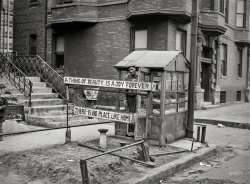
- Hello Kitty: 1958
- Chicago circa 1958. "American Cancer Society -- Circus lion tamer." Would you ... pose in the ring with brave souls.
(The Gallery, Cats, Chicago, Kids, News Photo Archive) ... Posted by Dave - 08/22/2015 - 3:04pm -
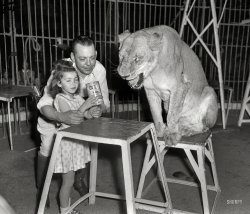
- Park Transfer: 1925
- ... car (N.K.P) is more accurately defined as: NKP - NEW YORK, CHICAGO & ST. LOUIS RR (NICKEL PLATE ROAD) now, of course, the NORFOLK ... Posted by Dave - 09/09/2013 - 5:06pm -
![Park Transfer: 1925 Washington, D.C., 1925. Something for the railfans, something for the truckfans. "O.D. Boyle" is all it says here. National Photo glass negative. View full size.
ToadsCarmen, inspectors who walked incoming trains before they were switched out (called "Toads" in railroad slang) carried a 1" diameter stick of chalk on their walks. If they found anything that needed minor attention (such as a loose bolt or cotter pin, brake shoes needing replacement, or worn air hose) they would chalk a symbol on the corner of the car to tell other repairmen. These symbols were not universal, and varied from yard to yard.
If they found a major defect (such as a brake defect, safety violation, or worn bearings) they stapled a postcard size card onto the side of the car, reading "Bad Order" and what the defect was. When the switchman broke up the train a Bad Order tag superceded any other instructions for the cars routing and it was placed in the "Rip", or repair yard.
Timeless boxcarsSome things change, some don't. Cars and trucks have changed tremendously in 88 years but a 1925 boxcar looks very much like a 2013 boxcar.
GMCThat's a GMC truck, probably about 1915. First GMCs were built in 1912. Already pretty old at the time of the picture.
As I See ItVisible marked rail cars, from left to right, hail from the Baltimore & Ohio (B&O), Nickel Plate (N.K.P.) and Louisville & Nashville (L&N), respectively. As for the truck, I'm thinking it's post-equine drayage. (Wikipedia helps here: http://en.wikipedia.org/wiki/Drayage.)
Team TrackThis would be a Team Track, where rail customers without spurs to them could receive goods. A series of parallel tracks, separated by a roadway where a team of horses with a wagon, and later motor trucks, could pull up alongside the railcars and transload goods from, or destined to, local customers.
As I (also) See ItThe reporting mark on that middle car (N.K.P) is more accurately defined as: NKP - NEW YORK, CHICAGO & ST. LOUIS RR (NICKEL PLATE ROAD) now, of course, the NORFOLK SOUTHERN RWY. CO.[*]. The name's origin is interesting as told here: Origin of the Name Nickel Plate Road.
Centrifugal Dirt CollectorThe things you learn at Shorpy. A few Googles and I was at pp. 88-89 of the December 1909 issue of "Air Brake Magazine". The subject collector is placed in the air line upstream of the triple valve. The shape of the chamber swirls the dirt around until gravity takes it to the bottom, where it stays.
This is the "B" endTo report mechanical issues, or describe anything concerning a railroad car, you need to be able to differentiate one end from the other. The "B" end of any car is the end where the hand brake is located. The opposite end is the "A" end. This practice is still followed today.
Boxcars then & nowThere is a world of difference between boxcars of a century ago and those of today, although these do look more modern than the solid-tired GMC truck. These boxcars have corrugated steel endwalls, but the sides of the one to the right are all wood. So you can imagine the steel-rod-and-turnbuckle structure on the bottom, the kind hobos are seen riding in the cartoons, and which needed constant adjustment. The knuckle couplers on these boxcars do not have the horizontal slot intended to receive a link during the transition from link-and-pin couplers of two decades earlier. It remains for better railfans than myself to say how quickly these were upgraded to solid knuckles.
Modern boxcars do not have a roofwalk, and the ladders do not reach the roof. Besides the work-related injuries of having brakemen climb up on the roof, there was the ever-present liability of unauthorized persons getting up there.
Since the '60s, boxcars, and all revenue rolling stock, have been getting larger. They have steadily been lengthened, and bridges have been raised to accommodate increased height.
Finally, journal boxes have given way to Timken roller bearings. I suspect the word "journal" refers to the fact that these bearings once required daily attention. The top-hinged doors on the boxes would seem to attest to this. A major reason cabooses (or cabeese) had cupolas on top was so the crew could watch out for overheating bearings.
My dad says that solid bricks of lubricant were available to dump into a problem journal box, as a stop-gap until the train could be brought into the yard. A large portion of his career at Texaco involved the development of an ideal lubricant for roller bearings, which since the '70s have completely replaced journal boxes.
Chalk MarkLower right side of closest car, just above the "pole socket": anyone know what it means?
O.D. BoyleO.D. Boyle was a yard brakeman for the B&O, working in Washington DC, in 1918. The connection to this photo is beyond me, though. See Page 22 here.
Pole SocketsPole sockets were the receptacles for push poles. Sometimes it was necessary (or at least convenient) for various reasons to move a car on an adjacent track that you could not couple your engine to. To accomplish that you used a push pole held in place by a crew member. The inherent danger of such a maneuver caused the practice to be outlawed relatively early on Class I railroads, but on backwoods short lines where operations were not so constricted by rules, it continued much later. And, railroads being railroads, no one really wanted to go to the trouble of changing any blueprints, and pole sockets continued to appear on equipment long after no current employee could remember seeing them used. Here's a photo of a push pole mounted under the tender of a Mississippi Central steam engine, probably from the 1930s.
Polin' the carsmichaeljy says the practice of poling cars was abandoned relatively early by Class I roads, but maybe not so ... in Winston Link's masterful history "The Last Steam Railroad in America," he includes two pictures (pages 100 and 101) of a brakeman poling a gondola on the Abingdon division of the Norfolk & Western some time between 1955 and 1957, when the division was dieselized completely.
Locomotives continued to be made with pole sockets right up until the end of steam.
(The Gallery, Cars, Trucks, Buses, D.C., Natl Photo, Railroads)](https://www.shorpy.com/files/images/SHORPY_32179u.thumbnail.jpg)
- Welcome Home: 1925
- ... in Washington playing the Senators. "Schalk & Mostil, Chicago, 1925." View full size. National Photo Company Collection glass ... to neuritis. OK, no, actually it's a blog devoted to the Chicago White Sox.
Denny Gill
Chugiak, Alaska
Red Faber's wife ... Posted by Dave - 08/03/2012 - 3:02pm -
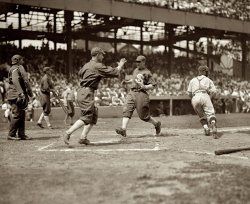
- General Outdoor: 1941
- July 1941. Chicago parking lot. View full size. 35mm negative by John Vachon.
... find my automobile!
(The Gallery, Cars, Trucks, Buses, Chicago, John Vachon) ... Posted by Dave - 09/09/2011 - 11:21am -
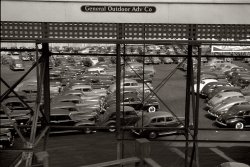
- Mule Room Boys: 1911
- ... he went to Detroit, MI.
By 1930 he he had moved to Chicago, IL and he was a salesman for a soda fountain supply company. He married Charlotte Strand on December 15, 1931 in Chicago. They later moved to Los Angeles, California where Cornelius died on ... Posted by Dave - 11/22/2009 - 8:07pm -
![Mule Room Boys: 1911 October 1911. Lowell, Massachusetts. "Robert Magee (smallest), 270 Suffolk Street, apparently 12 years, been working in Mule Room #1, Merrimac Mill, one year. Michael Keefe (next in size), 32 Marion Street, been at work in #1 Mule Room for eight months; apparently 13 years old. Cornelius Hurley, 298 Adams Street, been at work in #1 Mule Room for six months; about 13 or 14 probably." Photograph and caption by Lewis Wickes Hine. View full size.
What the heckis a mule room?
[It's the room in a cotton mill that houses the mules, or yarn-spinning machines. - Dave]
Ya gotta lovethose shoes!
Sense of prideWhen I see these old photos of boys outside of their workplace (and sometimes inside), they seem so proud of themselves. I wonder if it's because they are having their photo taken or because they have a job? I'm not saying bring back child labor, but there's a difference in the faces of a tween in a school photo and in a work photo from back then.
If ya ask meI'd say the big boy is sweet on the little boy!
And if ya ask meBig brother just gave little brother a "Wet Willie!"
Hurley FamilyCornelius Hurley's father was Michael Hurley who worked for the city as a laborer (pick and shovel), was 41 in 1910, and was a widower before 1900. His mother's maiden name was Sarah Dempsey.
Cornelius (13) had two brothers and a sister. His brothers John J. (16) and Michael J. (15) both worked in a carpet mill and had not attended school in the last year. He and his sister May/Mary A. (14) were still attending school in 1910.
He served in WWI.
By 1920 their last name had changed to Herlihey. His father is still working for the city as a laborer and Cornelius has now joined him in the same capacity with the city. His brother John is a weaver at a carpet mill. His brother Michael and sister Mary are working as clerks for a candy manufacturer. They are all still living at 298 Adams Street.
In 1926 he went to Detroit, MI.
By 1930 he he had moved to Chicago, IL and he was a salesman for a soda fountain supply company. He married Charlotte Strand on December 15, 1931 in Chicago. They later moved to Los Angeles, California where Cornelius died on November 1, 1953.
(The Gallery, Kids, Lewis Hine)](https://www.shorpy.com/files/images/02393u.thumbnail.jpg)
- Bar Mizpah: 1937
- ... Beerbank, California.
In the background You see the Chicago, Burlington & Quincy Railroad depot and the tracks. This building ... Posted by Dave - 01/15/2014 - 1:04pm -
![Bar Mizpah: 1937 August 1937. "Former bank, now a saloon. Mizpah, Minnesota." Medium format negative by Russell Lee for the Farm Security Administration. View full size.
Record breakerMizpah had a population of 56 in the 2010 census. It holds the record for the latest snowfall in the state: an inch and a half on June 4, 1935.
Grain Belt BeersGrain Belt 'Premium', a pretty decent beer, was sold in the bar/restaurant of the old Hector Field airport at Fargo, North Dakota during the 1970s.
Lucky StrikeEndorsing Lucky Strike cigarettes ("It's Toasted!") from beneath the awning is British actress Madeleine Carroll, the cool blonde in Hitchcock's 1935 thriller, "The 39 Steps." In '37, she appeared in three films: "On The Avenue," "It's All Yours," and the superb "The Prisoner of Zenda."
What it isIt's a Cannonball Alarm Company "Bug" bank vault alarm box, as seen here: http://www.flickr.com/photos/43678707@N02/5738392330
You gotta love the internet!
Another GuessThe mystery box could be the exhaust for the vault ventilator. BTW, I liked "Liquid Assets" better but "Bar Mizpah" is pretty darn good too.
Box on the Wall???What is the box on the wall above the awning near the roof line?
I am betting that it is an exterior alarm bell left over from the buildings earlier days as a bank. If not then it appears to contain a giant spider.
Edit...
WOW! Based on betabox's research in his post above I was almost right on both counts. The only difference is his link looks more like a beetle than my giant spider.
Building, built to lastI wonder what its used for these days?
View Larger Map
Architectural DetailsWhat the heck is this.
Excellent business planI reckon nobody ever went broke turning anything into a bar in rural Minnesota.
Mizpah, Minnesota The building, located at 101 Woodland Ave, is currently the home of the Mizpah Post Office. I called them, and the clerk confirmed it.
[Actually, the post office is in a newer building a block and a half north at Woodland and Cedar, as noted in a comment above. -tterrace]
Boy, was I offI thought this was Beerbank, California.
In the backgroundYou see the Chicago, Burlington & Quincy Railroad depot and the tracks. This building is located at the corner of Woodland Ave. & Pleasant St. The Post Office building is at Woodland Ave. & Cedar St.
Not a CB&Q (Burlington Route) depotbut rather Northern Pacific Railroad. (Minnesota & International subsidiary anyway). The "Q" never went anywhere near this far north. Burlington Northern took up the rails here in about 1992 and is probably why someone thought this was former "Burlington".
(The Gallery, Eateries & Bars, Russell Lee, Small Towns)](https://www.shorpy.com/files/images/SHORPY_8b38889u.thumbnail.jpg)
- Manned by Women: 1942
- August 1942. Republic Drill and Tool Co., Chicago. "Pioneers of the production line, these two young workers are among ... They're glowing August of '42 in a machine shop in Chicago. I'd say it was pretty warm in there.
Women Can Do It! Even my ... Posted by Dave - 06/01/2014 - 12:26pm -
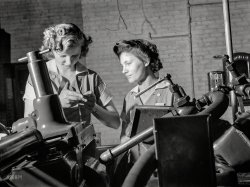
- Hot Mama: 1946
- " Montrose Beach , Chicago, 1946." Our Michigan mother, last seen here and here , working ... [He's reading a newspaper. -tterrace]
(Kodachromes, Chicago, Michigan Kodachromes, Swimming) ... Posted by Dave - 03/15/2018 - 10:37am -
![Hot Mama: 1946 "Montrose Beach, Chicago, 1946." Our Michigan mother, last seen here and here, working on a Great Lakes suntan. 35mm Kodachrome slide. View full size.
What Is That Thing?What is that gentleman on the left holding up? A sun reflector, a poor man's shade maker or light weights for a low impact workout?
[He's reading a newspaper. -tterrace]
(Kodachromes, Chicago, Michigan Kodachromes, Swimming)](https://www.shorpy.com/files/images/SHORPY-031NA.thumbnail.jpg)
- Newsies and Dog: 1909
- ... dad, born 1919, loved to demonsrate his pitch, "St. Louis, Chicago, and Denver aaaaaper" which he used while selling newspapers in the ... Posted by Dave - 07/27/2012 - 9:38am -
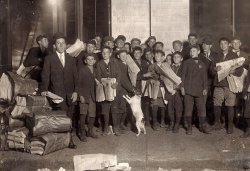
- Sun Porch: 1920
- ... of universities at the same time - at the University of Chicago and M.I.T.
The charm of the old house Many of these sun ... Posted by Dave - 09/13/2011 - 2:24pm -
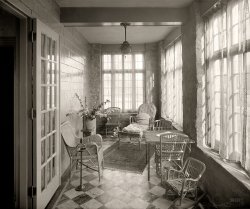
- W.M. Freeny: 1920
- ... Albert Spalding opened his first sporting goods store in Chicago in 1875 or '76 with his brother. Spalding was a well known pitcher and by 1876 was playing with the Chicago White Stockings (now the Cubs) so his name on a store was going to ... Posted by Dave - 08/08/2012 - 12:51pm -
![W.M. Freeny: 1920 Washington, D.C., circa 1920. "W.M. Freeny Co., front." The W.M. Freeny men's clothing store on 14th Street. National Photo Co. glass negative. View full size.
Flotsam and jetsamStrange that the photographer would have left that ugly ladder standing there to detract from his photo. And what in the world is it that was won by the Police in 1917? We'll probably never know......
I remember haberdasherieswhose well-trained clerks who worked in such fine stores supplying all manner of men's furnishings. Harry Truman was one before he became president. And they provided such good service that they would do free alterations to make your clothes fit perfectly, even if they were not custom-made.
And then, if you found clothes that would fit, you could go next-door to Velati's and stock up on famous caramels, bonbons, chocolates and pastries.
This was what a typical Main Street looked like when I was young and I must say, I found it much more personal than going into a cavernous super huge warehouse that sells everything under the sun, you push a massive, two-story shopping cart, walk a mile or more to find ALL your needs and finally take a number to check out. Believe me young ones, some things were better in the olden days.
Mysterious LadderThat looks like an extension ladder for work in trees, or maybe street lamps. Fruit pickers had ladders like these, narrow at the top to make them easier to use in the branches, but it would work as well on sidewalk light standards. Probably not the photographer's. The shop window it's propped against (glass already cracked) looks like maybe the display window for a pawn broker. There's also a set of golf clubs and a croquet set in the window with the police trophy, and maybe a radio tuner. The odd array of giblets for sale isn't packed densely enough for a hardware or sporting goods store.
[It's the A.G. Spalding & Bros. sporting goods store at 613 14th Street -- A.G. being Albert Goodwill Spalding of baseball fame. - Dave]
Velati CaramelsMy dad always said that if he had his life to live over, he'd live over a delicatessen. I might choose the Velati Famous Caramels shop.
Freeny lit upLooks like a warm late afternoon when this pic was snapped. I would love to have seen what the Freeny sign looked like at night, all lit up.
Shorpy viewers are the best!As soon as I saw this shot, I wondered just how quickly we'd know about the businesses on either side. You guys are just great. Thank you and Happy Fourth to all!
[More on Velati Caramels here and here. - Dave]
Sporting SpaldingAmazing detective work! So was this store part of a chain?
Where's the window cleaner?The ladder is very likely a widow cleaner's. There are at least a couple of window cleaners here who ply there business walking from location to location, carrying their equipment including a ladder like this.
Albert G Spalding"So was this store part of a chain?"
Yes. Spalding Sporting Goods began when Albert Spalding opened his first sporting goods store in Chicago in 1875 or '76 with his brother. Spalding was a well known pitcher and by 1876 was playing with the Chicago White Stockings (now the Cubs) so his name on a store was going to drive traffic. Spalding published the first guide to the rules of baseball, and an annual Baseball Guide. By 1901 the store in Chicago had grown to a chain of 14 stores. Spalding died in 1915 but the company still exists, although not as a retail entity - it is Spalding Sporting Goods and produces balls for many sports - although as far as I can tell from their website, they no longer make baseballs.
(The Gallery, D.C., Natl Photo, Stores & Markets)](https://www.shorpy.com/files/images/29399u1.thumbnail.jpg)
- Near Normal: 1900
- ...
Location Mile post C124, must be 124 miles to Chicago, Ill.
Rail to be straightened. The rail to be straightened ... they've obviously been well maintained. This is along the Chicago & Alton route between Chicago and St. Louis.
Archbar trucks and ... Posted by Dave - 10/09/2015 - 12:43pm -
![Near Normal: 1900 Circa 1900. "Track to be straightened. Normal, Ill's." 8x10 inch dry plate glass negative, Detroit Photographic Company. View full size.
StraighteningThe straightening spoken of is probably just that. The curvature may be too severe for the escalating speeds that railroads were beginning to see. Realigning was sometimes done to gain grade improvements as well. The derail probably remained if cars were still left on that track if they could endanger the main line.
Air BrakesThe car in the background by the platform does have air brakes, as evidenced by the presence of a brake hose dangling to the right of the coupler. The car in the left foreground does not appear to have air brakes.
The air brake in its present form was introduce in 1869, but there was no requirement that they be installed on all cars. Cars without air brake equipment were run at the rear of the train so that the cars with the equipment could be strung together at the front of the train under the control of the engineer. If the engineer needed more braking force than could be provided the equipped cars alone, whistle signals advised the conductor and rear trainman to walk to the top of the train setting handbrakes.
The type of control valves in use by 1900 were only reliable for trains up to about 20 cars, so frequently longer trains were run with the air hoses connected on only the front portion of the train and the remainder of the train was still controlled by handbrakes as described above. These were called "part air" trains.
Improvements to brake valves introduced in 1906 allowed longer trains, with up to 40 cars controlled by air brakes. The type AB brake valve on cars, introduced in 1933, permitted reliable control of a train with air of up to 150 cars, and part air trains disappeared shortly after that.
Arch bar trucksArch bar trucks were legal on interchange railroads until 1940, but they had been being phased out for decades before that.
They were used a lot longer than that on non-interchange lines like the SP narrow gauge -- one of the boxcars in our collection (SP 10) was still in service on the Inyo-Kern SP in 1960. Southern Pacific Boxcar 10 Repack Date This wooden Carter built boxcar was originally built in 1880. It is still sitting on trucks on our track in Fremont, CA. It could be one of the longest 'in service' box cars in the world--hard to say though.
LocationMile post C124, must be 124 miles to Chicago, Ill.
Rail to be straightened.The rail to be straightened reference you mentioned is a derail and is controlled by rodwork from either a tower in back of the photographer or the depot building.
Interesting bit of trackworkThere is a derail built into the rail closest to the viewer. It is controlled by the rods along side the track. Its purpose was to prevent runaway cars from fouling the main line. Seldom seen in the modern era.
Interesting scene.Archbar trucks were legal for many years after this photo. Interesting details here: note the grain door in the boxcar at left; also the point derail in foreground and dwarf signal operated by pipe rodding from a tower behind the photographer.
Another detail is the home signal on the gantry ... it is two-position with only red and white colors, which was standard on most railroads until a few years later. The signal is operated with long wires, which you can see alongside the pipe rodding in foreground.
Old CarsI know steam locomotives, not cars, but these seem a bit outdated even for 1900. They look at best 1880's vintage, though they've obviously been well maintained. This is along the Chicago & Alton route between Chicago and St. Louis.
Archbar trucks and brakewheelsDefinitely a transition era-- the wooden box cars have archbar trucks with wooden bolsters; journal boxes with babbit metal bearings; body hung brakes with no signs of airbrakes, but they have Janney knuckle couplers.
Can you image being a brakeman on these boxcars? Having to run on the roofwalk and jump between cars to turn the brakewheels to stop or slow these cars. yikes.
If it wasn't labeled "Normal [Ill.]I might have placed the scene in Peculiar, Mo.
(The Gallery, DPC, Railroads)](https://www.shorpy.com/files/images/SHORPY-4a20206a.thumbnail.jpg)
- Whoosh: 1942
- ... December 1942. Time exposure of repair tracks of the Chicago & North Western R.R. View full size. 4x5 Kodachrome ... by Jack Delano.
(The Gallery, Kodachromes, Chicago, Jack Delano, Railroads) ... Posted by Dave - 08/30/2012 - 12:00pm -
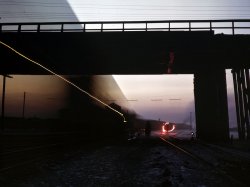
- A Bird in the Pan: 1943
- January 1943. "Chicago, Illinois. In the kitchen of one of the Fred Harvey restaurants at ... it's a shell of what it used to be.
(The Gallery, Chicago, Eateries & Bars, Jack Delano, Kitchens etc.) ... Posted by Dave - 11/22/2017 - 1:40pm -
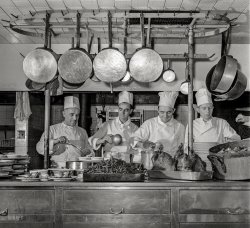
- Howard's Chicken Shack: 1943
- ... man myself Delivery available today! Harold's is a Chicago institution!
559 2nd Ave According to ... Posted by Dave - 07/03/2016 - 12:14pm -
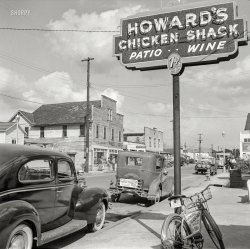
- The Final Cut: 1960
- ... barber shop. Republic Building, 209 South State Street, Chicago. Architects, Holabird & Roche. Completed 1905; demolished 1961." ... a bit of time going back in time here.
(The Gallery, Chicago, HABS) ... Posted by Dave - 09/25/2016 - 7:48pm -
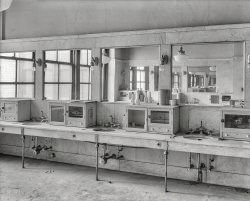
- The Mailpipe: New York
- ...
The tubes -- others snaked under Boston, Philadelphia, Chicago and St. Louis -- were put into use by the United States Post Office in ... Posted by Dave - 08/19/2012 - 1:47pm -
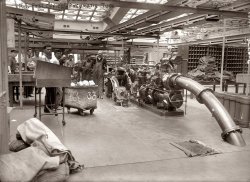
- Marilyn: 1921
- ... (3-35)" ordered for the princely sum of $10,000 at the Chicago Auto Fair in early 1920.
See here for what I've been able to piece ... Posted by Dave - 07/24/2012 - 9:57pm -
![Marilyn: 1921 New York circa 1921. "Miller." Stage actress Marilyn Miller in the driver's seat. 5x7 inch dry plate glass negative, George Grantham Bain Collection. View full size.
Amazing "print" qualityKudos on such stunning tonal reproduction. I'm certain there was never a paper print made from that piece of film which had such superb detail and such full dynamic range gradation. Wow.
[Strictly speaking, there's no film here. This is a glass plate. - Dave]
ContrastsThere is something so engaging about this photograph. The dark background, contrasting with every pintuck and frill on her collar and cuffs, the slight untidiness of her hair as a breeze lifted it - action arrested, a Real Person doing Real Things. (Well, pretending to, at least.) I love how huge those steering wheels were.
Very famous gal in her dayMM had quite the life; lots of successes, marriages and divorces (no kids) and an early death at 37; too sadly typical for Hollywood starlets.
[It was sinus surgery that did her in. - Dave]
Broadway legendMaybe not intentional a description, but Miller should never be in the same sentence as "Hollywood starlet." She was a bona fide Broadway legend of the highest rank in the 1920s. She made a few early talkie movies, but her fame was unparalleled on the stage, however tragically brief.
Colorized version of MarilynI couldn't resist. Here is the small view. Hopefully the larger version will be here soon.
The carI think you'll find this is the very same car Marilyn's first husband, Frank Carter, killed himself in. I couldn't believe it when a friend and I pieced it all together. If you look in the lower right of the image, just below the start of the vertical lines on the glass plate, you can make out an overpainted "MM&", the very same monogram visible in a larger version of the attached image which was taken outside of the Packard offices in Detroit.
It's a "1920 Packard Twin Six 4-passenger Special Touring by Fleetwood (3-35)" ordered for the princely sum of $10,000 at the Chicago Auto Fair in early 1920.
See here for what I've been able to piece together...
https://www.facebook.com/TheOriginalMarilyn/posts/1090593304391577
(The Gallery, Cars, Trucks, Buses, G.G. Bain, Movies)](https://www.shorpy.com/files/images/SHORPY_32518u.thumbnail.jpg)
- Mad Men: 1943
- ... and Carbon Building not the famous skyscraper in Chicago, but the more modest one in New York City.
The Union Carbide and ... Posted by Dave - 07/16/2014 - 10:19am -
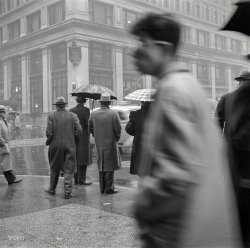
- House Beautiful: 1959
- ... president at one time of the Kimball Piano Company out of Chicago. While I couldn't find much on him online, his wife, Wilmot, was a ... two children, and four servants at 1415 Astor Street in Chicago, where he was renting an apartment for $500. That would be somewhere ... Posted by Dave - 09/30/2014 - 3:29pm -
![House Beautiful: 1959 Feb. 23, 1959. "Salisbury, residence in Hobe Sound, Fla. Ocean facade. William Kemp Caler, architect. For House Beautiful." The cocktail hour commences on the patio in five minutes. 5x7 inch negative by Gottscho-Schleisner. View full size.
Classic mid-century designThis is one of the best mid-century designs. When I contrast this with the McMansions being constructed today I would choose this in a heart beat. Livable spaces, excellent use of space, reasonable cost of construction and single level explains why this one of the best family home designs of the 20th century. Today building lots are narrow and multiple story designs are popular, but I would choose this is a Mississippi minute! Fortunately there are a lot of these homes on the re-sale market.
And at DuskThe tiki torches come out in force.
Lots of RoomFor a pool and a fire pit.
Invited guests onlyNo alligators or snakes, and no children or small animals to draw them.
Lean on meWhen the big wind comes those tree "braces" will snap like toothpicks
Heir to the WW Kimball Piano CompanyKimball Salisbury was president at one time of the Kimball Piano Company out of Chicago. While I couldn't find much on him online, his wife, Wilmot, was a darling of the Society pages in the newspapers -- google "Mrs Kimball Salisbury" and you'll get a slew of articles.
I haven't pegged where the house was actually located in Hobe Sound, but I doubt I'd be able to because it was listed as an "estate" in one newspaper article, which means it probably wouldn't be visible by Google Street View anyhow.
Mr. Salisbury appears in the 1930 Census living with his wife, two children, and four servants at 1415 Astor Street in Chicago, where he was renting an apartment for $500. That would be somewhere north of $7,000 a month in 2014 money.
I couldn't find them for whatever reason in 1940.
Not a fanThose windows look jalousie.
[Louver come back. - Dave]
Perfect for a house concert!With a few hundred of your best friends on blankets in the grass, the band on the patio, guys on surfboards groovin to the tunes... Heaven!
On the beachif it's ocean facade as the intro states, it's likely Jupiter Island. I've seen many similar style homes there.
(The Gallery, Florida, Gottscho-Schleisner)](https://www.shorpy.com/files/images/SHORPY-5a26486u.thumbnail.jpg)
- Caught in Passing: 1941
- April 1941. "Street scene, Chicago 'Black Belt'." 35mm nitrate negative by Edwin Rosskam for the ... Could be Marlowe.
(The Gallery, Cars, Trucks, Buses, Chicago, Edwin Rosskam) ... Posted by Dave - 05/05/2014 - 12:42pm -
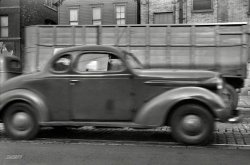
- Land Title Trust: 1905
- ... right of the Annex. Both buildings were the work of the Chicago office of D. H. Burnham & Co. - the first building built in 1897, ... The first building adheres closely to the designs of the Chicago School, and it looks very much like a classicized version of Burnham's ... Posted by Dave - 07/30/2012 - 10:09pm -
![Land Title Trust: 1905 Philadelphia circa 1905. "Land Title Trust Building." 8x10 inch dry plate glass negative, Detroit Publishing Company. View full size.
Yes sir - those were the days!Click the Hi-Def or View Full Size and bring in just the bottom quarter of the photo - looks exactly like the opening scene of a movie taking place at the turn of the century, perhaps staring Dan Dailey or Betty Grable.
Union League and Land Title Bldg.These are pretty much the same today as they were back then I believe. Though these days women can join the Union League -- the smaller red brick building with the elegant curving stairs -- but that's a very recent development.
Daniel Burnham Strikes Again!The big building in the center of the picture is the Annex (or South Tower) of the original Land Title and Trust Building, a sliver of which may be seen to the right of the Annex. Both buildings were the work of the Chicago office of D. H. Burnham & Co. - the first building built in 1897, the second in 1902. The first building adheres closely to the designs of the Chicago School, and it looks very much like a classicized version of Burnham's Fisher Building in Chicago (1895-1896). The second building, designed with contributions by the Philadelphia architect Horace Trumbauer, fits fully into the Beaux-Arts skyscraper mode, with a tripartite facade composition featuring columns at the bottom and also near the top.
Other building?Can anyone tell what was in the third building on the crossing we see?
"THE NORTH ......CAN" before the "CAN" there must be a B, D, P or R, I think.
[The one at the right is the North American Building. - tterrace]
RestroomsLast year, I had to visit that building once per week during the last quarter. The restrooms feature water-free urinals and other state of the art equipment. Not bad for a building well over a century old.
(The Gallery, DPC, Philadelphia)](https://www.shorpy.com/files/images/SHORPY_4a12591a.thumbnail.jpg)
- R.F.K., R.I.P.: 1968
- ... Admiral",an express train heading to New York City from Chicago came around the curve just south of the station. "The Admiral's" GG1 ... Posted by Dave - 05/13/2013 - 8:54pm -
![R.F.K., R.I.P.: 1968 June 8, 1968. "Funeral cortege of Robert F. Kennedy." Thousands of people lined the tracks as the train carrying RFK's casket made the eight-hour journey from his funeral in New York to Washington, D.C. 35mm Kodachrome transparency. From photos by Paul Fusco and Thomas Koeniges for Look magazine. View full size.
CurlersThat was a common thing, to go out before your curls had set, and the butt of not a few jokes. Nobody does that anymore. Do they even still make curlers?
In the '80s, my dad worked next door to the Ambassador Hotel, where RFK was shot. I remember him taking me there and showing me the exact spot.
A further tragedyAs the funeral train approached Elizabeth, New Jersey, two people who were standing on an adjacent track to get a view of the funeral train were fatally struck by another train.
Two SidesWonder what the people looked like on the other side of the tracks.
Photographed From?Was this taken from the moving train, or from across the tracks?
Something Happening HereFusco's photos from the RFK funeral train (published in book form for the first time a few years ago) present a deeply moving group portrait of a specific instant in American history. You feel all of the country is on display, united, fleetingly, in confusion and grief. The blurred backgrounds, which contribute so much to the sense of the world unfurling outside the train window, were the unwanted but inescapable result of the ASA 25 film he was using.
Between this post and the previous two, there's a James Ellroy novel in the making.
Re: Photographed From?Definitely from the moving train.
As Hackensacker commented on the slow 35mm film, the blurred background is a result of the photographer panning the shot to keep the mid-ground people fixed in the frame. You can see a lesser degree of lateral blurring in the foreground foliage, as well.
Time warpI thought Kennedy was assassinated in 1963.
[Yes. -tterrace]
On display to the world "You feel all of the country is on display..."
Yes. When RFK was killed, my parents were stationed by the Foreign Service in Europe; we were in a restaurant in England right after we found out about the shooting, and there was a strong buzz of comments on the order of "These Americans shooting everyone who matters." The comments were genuinely aghast and puzzled, not mean spirited, but we were for sure on display to the world. Martin Luther King had just been shot at a moment when his fame and importance were growing overseas, and I had just been in a rather small "race riot" of demonstrations after his shooting; not a real riot, but exciting and disturbing stuff in my college town of Carlisle, Pennsylvania. As with JFK in 1960, RFK and MLK were overwhelmingly popular overseas, far more so than in there own country. I felt like a citizen of a surreal pariah nation that summer.
Three KennedysMr. WMtraveler. You are correct, but not totally right. There were three Kennedy Brothers, John (Jack), Robert (Bobby) and Edward (Teddy). Two of them were assassinated, John in 1963 and Robert in 1968.
[There were four Kennedy brothers. -tterrace]
Final, 60's version of a tradition?What a wonderful photo of the last gasp of funeral trains and of public observance of such grief. Very 60's. Can't recall any major public funeral trains after this one.
Elizabeth, NJ AccidentI was there. The crowd was so large I climbed a fence with a pole alongside. Stood on top of the fence with one arm around the pole, the other holding my camera.
Platforms were ground level and the crowd moved onto the tracks to get a view of the special train. "The Admiral",an express train heading to New York City from Chicago came around the curve just south of the station. "The Admiral's" GG1 locomotive sounded its horn,a long loud blast, but some of the people in the crowd did not clear the track in time and sadly two were killed and four seriously injured.
After the tragic accident the Penn Central ordered all train movement stopped until the special train passed. The funeral train arrived in Washington's Union Station four hours behind schedule and had caused disruption to the entire railroad.
RFK funeral trainDear all, (and AndyB who posted on 05/16/2013) can you please contact me? I would love to get in touch with bystanders of their relatives, who stood alongside the tracks and made photos or films of the funeral train of Robert F. Kennedy. As a Dutch photographer and teacher I am doing research on photography and memory. Even though I do work and live in the Netherlands, I sense that this event will still arouse vivid memories in the minds of many Americans. The images I am looking for don't have to be perfect, any visual material is welcome. I will gladly credit your photos and films wherever they’re used and I can compensate the potential expenses you need to make in digitizing the pictures. If you wish to learn more about my call, please, let me know. Thank you very much in advance for any kind of assistance!
Yours faithfully,
Rein Jelle Terpstra mail@reinjelleterpstra.nl
(LOOK, Railroads)](https://www.shorpy.com/files/images/SHORPY_22336u.thumbnail.jpg)
- Park-Vista: 1941
- ... April 1941. "Kitchenette apartments on South Parkway, Chicago, Illinois. These are rented to Negroes." Medium format negative by ... the apartment.
(The Gallery, Cars, Trucks, Buses, Chicago, Russell Lee) ... Posted by Dave - 09/25/2018 - 11:55am -
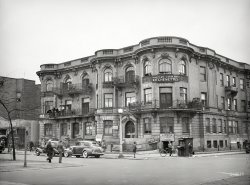
- Buy a Slug: 1941
- April 1941. "South Side Chicago. Telephone booth in Negro tavern." The Bronzeville watering hole known ... the Use of Slugs...". A little research shows that Chicago has a law against using a slug in a fortress pay phone to make a ... box. It's still on the books, at the Municipal Code of Chicago, section 8-8-180. That section only has two clauses, but I think the ... Posted by Dave - 09/30/2019 - 1:54pm -
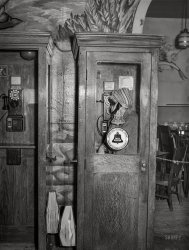
- Johnnie X: 1908
- ... were used to ship watermelons to Northern cities like Chicago.
Boxcar Hatches Re: "The hatches on the end may have contained ... Posted by Dave - 09/09/2008 - 12:35am -
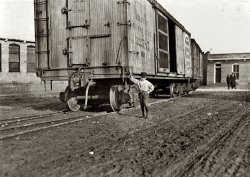
- Attic Bride: 1942
- ... any mountain home would welcome. Pressed Steel Can Co., Chicago." Photo by Ann Rosener, Office of War Information. View full size. ... 10, 1942." -tterrace]
(The Gallery, Ann Rosener, Chicago, WW2) ... Posted by Dave - 02/06/2014 - 3:00pm -
![Attic Bride: 1942 September 1942. "Manpower. Americans all. Husky, bright-eyed Joe Gore Jr. is a young American of Polish descent who is determined that Hitler shall be driven from Poland and kept from America's shores. Machining medium tank parts in a Midwest plant during most of the daylight hours leaves Joe in a quite weary state when evening rolls around. Joe's home shows vestiges of 'old country' influences, but his own personal attic sanctum is solid Americana. Note the Home Bride, and the rocker that any mountain home would welcome. Pressed Steel Can Co., Chicago." Photo by Ann Rosener, Office of War Information. View full size.
Pressed SteelI believe the correct name is Pressed Steel Car Company, not Can Company.
[Correct. From this link: "In 1940, during World War II, Pressed Steel started to produce large quantities of M-4 armored tanks and allied war materials for the war effort... Pressed Steel Car Company received an award for their excellent job in producing tanks on September 10, 1942." -tterrace]
(The Gallery, Ann Rosener, Chicago, WW2)](https://www.shorpy.com/files/images/SHORPY_8b07379a.thumbnail.jpg)
- Suicide Rations: 1945
- ... C. Robinson, Asheville, Class 44-G; Driskell B. Ponder, Chicago, 43-I; Robert W. Williams, Ottumwa, Iowa, 44-E. Gelatin silver print by ... Posted by Dave - 09/24/2012 - 6:33pm -
![Suicide Rations: 1945 March 1945. "Tuskegee Airmen series. 'Escape kits' (cyanide) being distributed to fighter pilots at air base in Ramitelli, Italy." Theodore G. Lumpkin Jr., seated, with (L-R): Joseph L. "Joe" Chineworth, Memphis, Class 44-E; Robert C. Robinson, Asheville, Class 44-G; Driskell B. Ponder, Chicago, 43-I; Robert W. Williams, Ottumwa, Iowa, 44-E. Gelatin silver print by Toni Frissell. View full size.
Lt. William A Johnston, USAAFI had the pleasure to know Tuskegee Airman Lt. William A "Billy" Johnston (1925-2005) of Pennsylvania. He matriculated with class 45-D, too late to join the war. When I knew him in the 1970s, he had a Cessna O-2 Skymaster that he flew from Oberlin, OH to St. Mary's County Maryland (among other places). He had striking, honey-colored eyes. In the attached photo, he's posing in the cockpit of a Curtiss P-40N Warhawk.
Handsome Rakes, ALL!PLEASE add them to the aforementioned category!
WWII "suicide pills"William Sterling Parsons and several other crew members of the B-29 Super-fortress bombers sent to drop atomic bombs on Japan in World War II were issued with lethal pills, though all aircraft returned safely and none of the pills were used. This was in case they were captured and then tortured by the enemy to reveal classified information regarding (at the time) atomic weapons.
We Americans Are Better Than ThatNo American fighting man in WWII was issued a "suicide pill" when going into action in uniform. Yes, Jewish flyers could have their dog tags altered to get their religion "changed" while flying over German territory but the American fighting man then and now does not go into action with suicide as an available option. Pilots and crewmen from an aircraft carried sidearms as a means to resist when shot down.
You screwed up Shorpy and my old man with the two Purple Hearts out of WWII ain't happy. My one Heart out of Vietnam as a Marine isn't thrilled either.
[Note the quotation marks; this is the caption attached to the photo in the Library of Congress archive. - tterrace]
"Could have a pretty good weekend in Vegas with all that stuff"Maps, gum, matches, Hershey bars, etc.
Benzedrine tablets ("pep pills," heh heh!) were commonly included, but I agree that the Library of Congress caption is in error about Cyanide.
[The LOC caption appears to be the sole source of all online references to cyanide supposedly being included in 'escape kits.' - tterrace]
One plausible explanationGullible stateside reporter...
[Definitely does not apply to Toni Frissell. The LOC file attributes the identity of the airmen in part to Frissell's notes, but not the caption specifically. - tterrace]
(The Gallery, Aviation, Toni Frissell, WW2)](https://www.shorpy.com/files/images/SHORPY_09549u.thumbnail.jpg)
- Kiewel Beer: 1940
- ... View Larger Map
Barren Once again, like the Chicago photo, few people and an angle chosen that makes it seem that you're ... Posted by Dave - 11/16/2011 - 11:45am -
![Kiewel Beer: 1940 October 1940. "Grand Forks, North Dakota." 35mm nitrate negative by John Vachon for the Farm Security Administration. View full size.
A different use for grainInstead of selling beer, that location is home to a bakery. The Dotty Dunn hat store was at 17 N. 3rd Street. It, the bar and the dry cleaners are all gone, even the cut rate store to the left. The only building that survives is the one to the extreme right. Which appears to have a barber shop. BTW, Dotty Dunn Hats was a chain store operation.
View Larger Map
BarrenOnce again, like the Chicago photo, few people and an angle chosen that makes it seem that you're looking down on a detailed area of a really cool O-gauge layout. Perhaps that's what Vachon was trying to capture.
Bull City Boy has a great question, what is that automobile? A totally different look from the others. I haven't clue alas, [Lincoln Zephyr?] but now I gotta find out. What is it?
Anywhere, U.S.A.Nostalgic picture which is so similar to the small town in which I grew up but on the East Coast. Our businesses on Main Street (with the same kind of diagonal parking before meters) were Carroll Cut Rate, Adam's Hats,Gene's Bar featuring Rheingold beer, Pete's Barber Shop and Bashura's Shoe Repair. I used to love the fumes in the shoemakers and cleaners, both now deemed very lethal, i.e. shoe polish, glues, leather-tanning chemicals and carbon tetrachloride. We also had a Hart's Five and Dime and a First National grocery. Kind of neat to think that whether you grew up in the East or Midwest, the small town Main Streets were so similar.
Brew NotesAs a side note, Kiewel's Beer was brewed in Little Falls, Minnesota, while Heileman's Old Style (hanging sign over the tavern door) was brewed in La Crosse, Wisconsin.
Interior HingesSo, is no one going to identify the autos, especially the fourth from the left?
P.S. I've been away for five weeks. Glad to be back and I'll be catching up with Shorpy as best I can.
Inflation$1.98 in 1940 would be about $32 today. Not a bad price for a man's hat.
Cars ID'dFrom left,
1940 Chevy with deluxe rear center guard.
1937-38 Chrysler
1937 Nash
1939 Chrysler?
1940 Oldsmobile
Comments welcome.
The vehicle 4th from the left is a 1939 Ford Deluxe 2 door sedan. Better later than never.
(The Gallery, Cars, Trucks, Buses, John Vachon)](https://www.shorpy.com/files/images/SHORPY_8a32539a.thumbnail.jpg)























